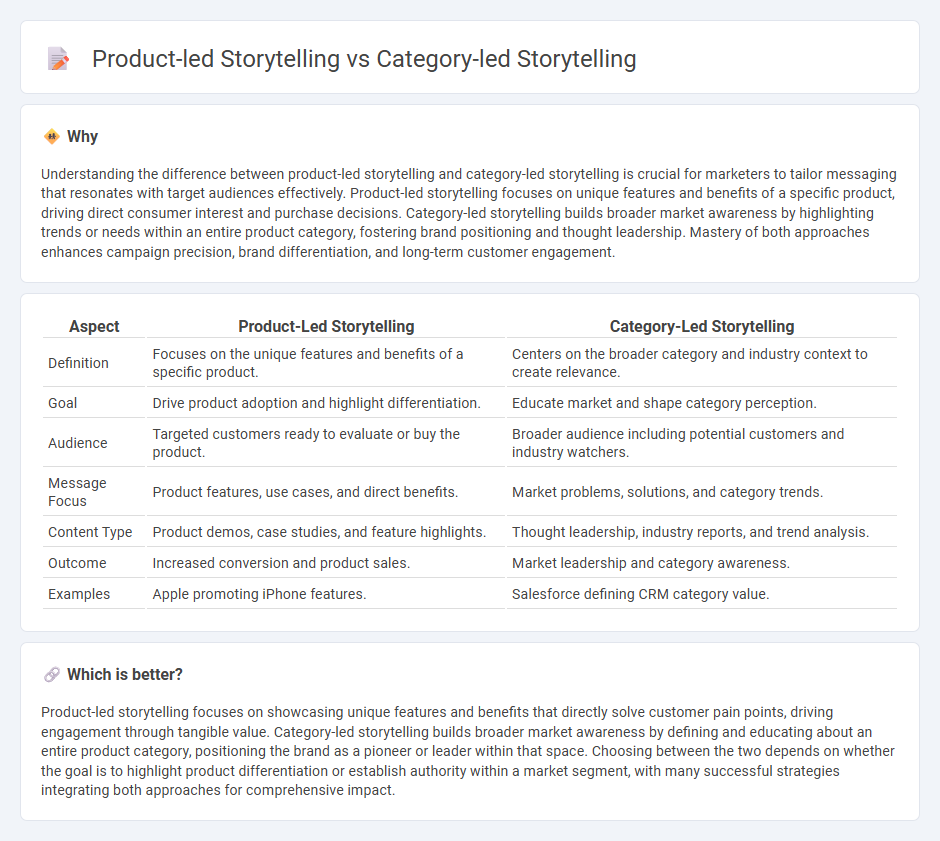
Product-led storytelling emphasizes showcasing a specific product's features, benefits, and unique value to directly engage customers and drive conversions. Category-led storytelling focuses on shaping the broader market category narrative, creating demand by defining the problem space and positioning products within that context. Discover how these storytelling approaches can transform your marketing strategy and boost brand impact.
Why it is important
Understanding the difference between product-led storytelling and category-led storytelling is crucial for marketers to tailor messaging that resonates with target audiences effectively. Product-led storytelling focuses on unique features and benefits of a specific product, driving direct consumer interest and purchase decisions. Category-led storytelling builds broader market awareness by highlighting trends or needs within an entire product category, fostering brand positioning and thought leadership. Mastery of both approaches enhances campaign precision, brand differentiation, and long-term customer engagement.
Comparison Table
| Aspect | Product-Led Storytelling | Category-Led Storytelling |
|---|---|---|
| Definition | Focuses on the unique features and benefits of a specific product. | Centers on the broader category and industry context to create relevance. |
| Goal | Drive product adoption and highlight differentiation. | Educate market and shape category perception. |
| Audience | Targeted customers ready to evaluate or buy the product. | Broader audience including potential customers and industry watchers. |
| Message Focus | Product features, use cases, and direct benefits. | Market problems, solutions, and category trends. |
| Content Type | Product demos, case studies, and feature highlights. | Thought leadership, industry reports, and trend analysis. |
| Outcome | Increased conversion and product sales. | Market leadership and category awareness. |
| Examples | Apple promoting iPhone features. | Salesforce defining CRM category value. |
Which is better?
Product-led storytelling focuses on showcasing unique features and benefits that directly solve customer pain points, driving engagement through tangible value. Category-led storytelling builds broader market awareness by defining and educating about an entire product category, positioning the brand as a pioneer or leader within that space. Choosing between the two depends on whether the goal is to highlight product differentiation or establish authority within a market segment, with many successful strategies integrating both approaches for comprehensive impact.
Connection
Product-led storytelling centers on showcasing unique product features and benefits to attract customers, while category-led storytelling emphasizes the broader market category to position the product within its competitive landscape. Both approaches intertwine by using category narratives to contextualize the product's innovations, enhancing relevance and consumer understanding. This synergy drives stronger brand differentiation and market demand by aligning product attributes with evolving industry trends.
Key Terms
Positioning
Category-led storytelling emphasizes defining and owning a new market space by highlighting the broader problem your offering solves, creating a unique position in the customer's mind compared to competitors. Product-led storytelling centers on showcasing specific features, benefits, and innovations of a product to demonstrate superiority within an existing category. Explore the nuances of positioning to learn how each storytelling approach can amplify your brand's impact.
Differentiation
Category-led storytelling emphasizes positioning a brand within a broader market segment, highlighting unique industry insights and redefining customer expectations to create differentiation. Product-led storytelling zeroes in on specific features, benefits, and innovations of a product to distinguish it from competitors within the category. Explore how mastering each approach drives stronger brand identity and customer loyalty.
Value Proposition
Category-led storytelling emphasizes the unique value proposition of an entire market segment, positioning a brand as a leader within its industry category. Product-led storytelling highlights specific features and benefits of an individual product, showcasing direct solutions to customer needs. Explore how aligning storytelling strategy with value proposition drives brand differentiation and customer engagement.
Source and External Links
What is category-led growth? - Boil Agency - Category-led storytelling means crafting a narrative that positions your brand as the go-to choice within a new or redefined market category, focusing on the customer's evolving needs rather than just the product or sales pitch.
Led Growth" Strategy That Ensures the Others Succeed - It involves evangelizing the category itself, becoming the thought leader who shapes how the market understands the problem and the solution, and driving adoption through compelling, problem-first storytelling.
Category Managers: Cut the cr*p and be a better storyteller - For category managers, effective storytelling is about moving beyond data and charts to connect with the audience emotionally, making the category's purpose and potential memorable and actionable.
 dowidth.com
dowidth.com